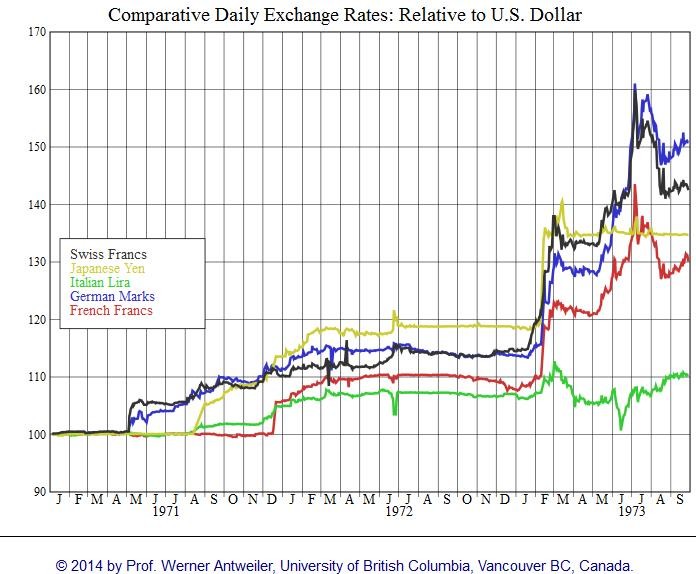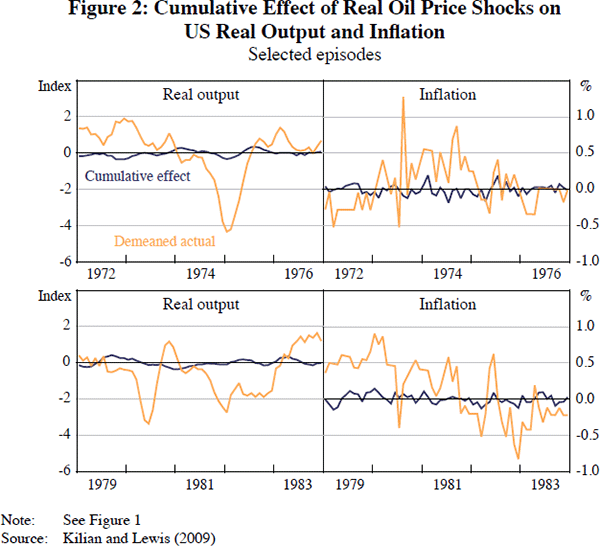Stagflation and the 1970s Oil Crisis Transmissions
Post on: 16 Март, 2015 No Comment

Stagflation and the 1970s Oil Crisis
In economics, stagflation is a situation in which the inflation rate is high and the economic growth rate slows down and unemployment remains steadily high. It raises a dilemma for economic policy since actions designed to lower inflation or reduce unemployment may actually worsen economic growth.
Economists offer two principal explanations for why stagflation occurs. First, stagflation can result when the productive capacity of an economy is reduced by an unfavorable supply shock, such as an increase in the price of oil for an oil importing country. Such an unfavorable supply shock tends to raise prices at the same time that it slows the economy by making production more costly and less profitable.
Second, both stagnation and inflation can result from inappropriate macroeconomic policies. For example, central banks can cause inflation by permitting excessive growth of the money supply, and the government can cause stagnation by excessive regulation of goods markets and labor markets. [9] Either of these factors can cause stagflation. Excessive growth of the money supply taken to such an extreme that it must be reversed abruptly can clearly be a cause. Both types of explanations are offered in analyses of the global stagflation of the 1970s: it began with a huge rise in oil prices, but then continued as central banks used excessively stimulative monetary policy to counteract the resulting recession, causing a runaway wage-price spiral.
The 1970s oil crisis really began in 1973. What we see in this crisis is the fact that prices of commodities like oil play a much more vital role in our economy than most think. The world needs so much oil every day to run, and will literally need to pay whatever it costs, or it will cease to run.
What we saw as a major cause of the 1970s oil crisis was the fact that oil prices were quadrupled by OPEC. This, along with the increased government spending which came with the Vietnam War, led to severe stagflation in the United States. This “oil shock”, along with the accompanying stock market crash, were considered by many to be the first events to have a persistent affect on the United States.
This also goes to show how much of an effect the Middle East had on life in the United States, as it was Middle Eastern countries that raised the price of oil.
In October of 1973 OPEC stopped exports to the US and other western nations to punish the support of Israel, they realized the strong influence that they had on the world through oil. The immediate results of the Oil Crisis were dramatic. Prices of gasoline quadrupled, rising from just 25 cents to over a dollar in just a few months.
In October of 1973 Middles-eastern OPEC nations stopped exports to the US and other western nations. They meant to punish the western nations that supported Israel, their foe, in the Yom Kippur War, but they also realized the strong influence that they had on the world through oil. One of the many results of the embargo was higher oil prices all throughout the western world, particularly in America.

The immediate results of the Oil Crisis were dramatic. Prices of gasoline quadrupled, rising from just 25 cents to over a dollar in just a few months. The American Automobile Association recorded that up to twenty percent of the country’s gas stations had no fuel one week during the crisis. In some places drivers were forced to wait in line for two to three hours to get gas. The total consumption of oil in the U.S. dropped twenty percent. This was do to the effort of the public to conserve oil and money. There was an instant drop in the number of homes created with gas heat, because other forms of energy were more affordable at this time. The U.S. government went to desperate measures to improve the situation that America found itself in. Congress issued a 55mph speed limit on highways. This was a good thing. Not only did oil consumption go down, but fatalities decreased overnight. Today’s fuel economy stickers come from the effort to preserve oil in the 70′s. Daylight savings time was issued year round in an effort to reduce electrical use. These changes were made in hopes of preserving oil.
Tax credits were offered to those who developed and used alternative sources for energy. These included solar and wind power. Nixon, who was president at that time, ordered the department of defense to create a stockpile of oil in case the country needed the military to carry it through a time of chaos. There was a large cutback in oil consumption. Emergency rationing books were printed although they were never necessary due to the end of the embargo. Nixon formed the Department and it became a cabinet office. It developed the national energy policy. They made plans to make the U.S. energy independent companies and stations also did all that they could to preserve oil. Nixon had issued a voluntary cutback on the consumption of gasoline. Gas stations would voluntarily close on Sundays. They refused to sell to customers who weren’t “regulars.” Gas stations also wouldn’t sell more than ten gallons of gasoline to a customer at a time. They felt that these efforts would help the public to become more fuel-efficient.
Although the embargo ended only a year after it began in 1973, the OPEC nations had quadrupled the price of oil in the West. The embargo opened a new era in international relations. It was a political and economical achievement for the Middle East. Third World states discovered that their natural resources, on which they depended upon, specifically oil, could be used as a weapon in both political and economical situations. The Rising oil prices continued to be a threat to not only America’s economy, but also that of the world. President Jimmy Carter would later call the oil situation in the 70’s “the moral equivalent of war.”
Never had the price of an essential commodity risen so quickly and dramatically. The vulnerability of the Western world had truly been revealed.














